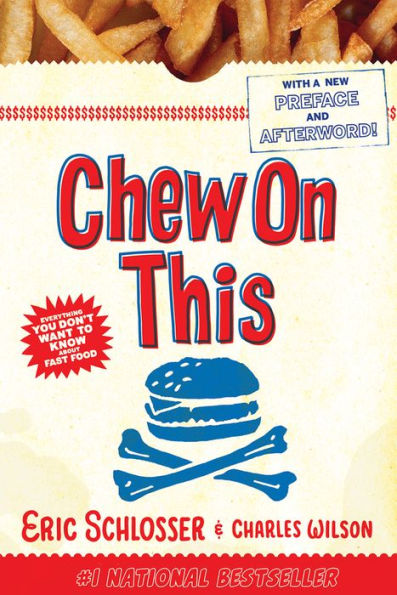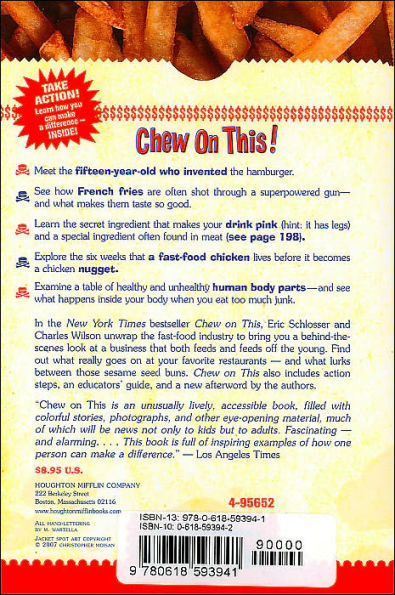Read an Excerpt
Pull open the glass door and feel the rush of cool air. Step inside. Look at the backlit color pictures of food above the counter, look at the cardboard ads for the latest Disney movie, get in line, and place your order. Hand over some money. Put the change back in your pocket. Watch teenagers in blue-and- gold uniforms busy working in the kitchen. Moments later, grab the plastic tray with your food, find an empty table, and sit down. Unwrap the burger, squirt ketchup on the fries, stick the plastic straw through the hole in the lid of your drink. Pick up the burger and dig in.
The whole experience of eating at a fast-food restaurant has become so familiar, so routine, that we take it for granted. It has become just another habit, like brushing your teeth before bed. We do it without even thinking about it—and that’s the problem.
Every day about one out of fourteen Americans eats at a McDonald’s. Every month about nine out of ten American children visit one. McDonald’s has become the most popular fast-food chain in the world—and by far the most powerful. In 1968 there were about 1,000 McDonald’s restaurants, all of them in the United States. Now there are more than 31,000 McDonald’s, selling Happy Meals in 120 countries, from Istanbul, Turkey, to Papeete, Tahiti. In the United States, McDonald’s buys more processed beef, chicken, pork, apples, and potatoes than any other company. It spends more money on advertising and marketing than any other company that sells food. As a result, it is America’s most famous food brand. The impact of McDonald’s on the way we live today is truly mind-boggling. The Golden Arches are now more widely recognized than the Christian cross.
Despite McDonald’s fame and all the money it spends on advertising, every day the vast majority of its customers don’t plan to eat there. Most fast-food visits are impulsive. The decision to buy fast food is usually made at the last minute, without much thought. People generally don’t leave the house in the morning saying, “I’m going to make sure to eat some fast food today.” Most of the time, they’re just walking down the sidewalk or driving down the road, not thinking about anything in particular. Maybe they’re hungry; maybe they’re not. Maybe they’re in a hurry and don’t have time to cook. And then they see a great big fast-food sign—the Golden Arches, the red-and-blue of a Domino’s pizza box, the picture of Colonel Sanders—and they suddenly think, “Hey, I want some of that.” So they stop to eat fast food. They do it because they feel like it. They just can’t resist the impulse.
The point of this book is to take that strong impulse we all feel— our hunger for sweet, salty, fatty fast foods—and make you think about it. Chew On This will tell you where fast food comes from, who makes it, what’s in it, and what happens when you eat it. This is a book about fast food and the world it has made.
Food is one of the most important things you’ll ever buy. And yet most people never bother to think about their food and where it comes from. People spend a lot more time worrying about what kind of blue jeans to wear, what kind of video games to play, what kind of computers to buy. They compare the different models and styles, they talk to friends about the various options, they read as much as they can before making a choice. But those purchases don’t really matter. When you get tired of old blue jeans, video games, and computers, you can just give them away or throw them out.
The food you eat enters your body and literally becomes part of you. It helps determine whether you’ll be short or tall, weak or strong, thin or fat. It helps determine whether you will enjoy a long, healthy life or die young. Food is of fundamental importance. So why is it that most people don’t think about fast food and don’t know much about it?
The simple answer is this: the companies that sell fast food don’t want you to think about it. They don’t want you to know where it comes from and how it’s made. They just want you to buy it.
Have you ever seen a fast-food ad that shows the factories where French fries are made? Ever seen a fast-food ad that shows the slaughterhouses where cattle are turned into ground beef? Ever seen an ad that tells you what’s really in your fast-food milk shake and why some strange-sounding chemicals make it taste so good? Ever seen an ad that shows overweight, unhealthy kids stuffing their faces with greasy fries at a fast-food restaurant? You probably haven’t. But you’ve probably seen a lot of fast-food commercials that show thin, happy children having a lot of fun.
People have been eating since the beginning of time. But they’ve only been eating Chicken McNuggets since 1983. Fast food is a recent invention. During the past thirty years, fast food has spread from the United States to every corner of the globe. A busssssiness that began with a handful of little hot dog and hamburger stands in southern California now sells the all- American meal—a hamburger, French fries, and soda—just about everywhere. Fast food is now sold at restaurants and drive-throughs, at baseball stadiums, high schools, elementary schools, and universities, on cruise ships, trains, and airplanes, at Kmarts, Wal-Marts, and even the cafeterias of children’s hospitals. In 1970, Americans spent about $6 billion on fast food. In 2005, they spent about $134 billion on fast food. Americans now spend more money on fast food than on college education, personal computers, computer software, or new cars. They spend more on fast food than on movies, books, magazines, newspapers, and recorded music— combined.
Fast food may look like the sort of food people have always eaten, but it’s different. It’s not the kind of food you can make in your kitchen from scratch. Fast food is something radically new. Indeed, the food we eat has changed more during the past thirty years than during the previous thirty thousand years.
In the pages that follow, you’ll learn how the fast-food business got started. You’ll learn how the fast-food chains try to get kids into their restaurants, how they treat kids working in their kitchens, how they make their food. And you’ll learn what can happen when you eat too much of it. These are things you really need to know. Why? Because fast food is heavily advertised to kids and often prepared by workers who are kids themselves. This is an industry that both feeds and feeds off the young.
For the most part, fast food tastes pretty good. That’s one of the main reasons people like to eat it. Fast food has been carefully designed to taste good. It’s also inexpensive and convenient. But the Happy Meals, two- for-one deals, and free refills of soda give a false sense of how much fast food actually costs. The real price never appears on the menu.
Hundreds of millions of people eat fast food every day without giving it much thought. They just unwrap their hamburgers and dig in. An hour or so later, when the burger’s all gone and the wrapper’s been tossed into the garbage, the whole meal has already been forgotten. Chew on this: people should know what lies beneath the shiny, happy surface of every fast-food restaurant. They should know what really lurks between those sesame seed buns. As the old saying goes: you are what you eat.
CHEW ON THIS: EVERYTHING YOU DON’T WANT TO KNOW ABOUT FAST FOOD by Eric Schlosser and Charles Wilson. Copyright (c) 2006 by Eric Schlosser. Reprinted by permission of Houghton Mifflin Harcourt Publishing Company. All rights reserved.








